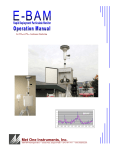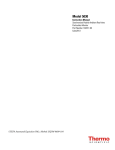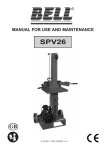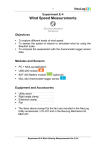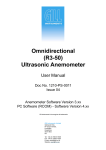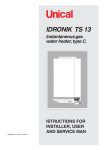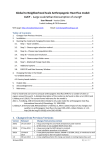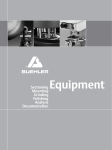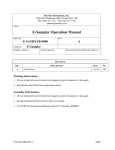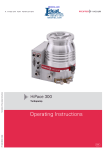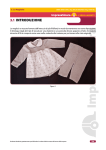Download Met One E-Bam Mass Monitor User Manual
Transcript
EBAM Training Manual Met One Instruments, Inc 1600 NW Washington Blvd. Grants Pass, Oregon 97526 Telephone 541-471-7111 Facsimile 541-541-7116 Regional Service 3206 Main St. Suite 106 Rowlett, Texas 75088 Telephone 972-412-4715 Facsimile 972-412-4716 Table of Contents Introduction_______________________________________________ 3 1 Flow System ___________________________________________ 5 A. Leak Check _____________________________________________________ 5 B. Flow Audit/Calibration ___________________________________________ 9 C. Inlet Heater ____________________________________________________ 12 2 Measuring System ______________________________________ 13 A. Self Test _______________________________________________________ 13 B. Membrane Test _________________________________________________ 14 3 Data System __________________________________________ 18 A. Analog Voltage _________________________________________________ 18 B. Download Data _________________________________________________ 19 E-BAM Systems Training 2 11FEB03 Introduction The E-BAM is an automated filter based TSP, PM10 and PM2.5 monitor. It has the same basic operation as manual filter based samplers such as the SSI (Size Selective Inlet High Volume Sampler) or the FRM (Federal Reference Method). These manual samplers consist of three sub-systems, which are the following: a Flow system, a Measuring system and a Data system. Typically the flow system consists of an Inlet separator, filter holder, flow meter, flow controller and a pump (Figure 1). Figure 1 Typical flow system for a Manual Filter based Sampler The measuring system requires a pre-weighed filter equilibrated at around 20 degrees Celsius and 45% RH. This filter is installed in the sampler and a known volume of ambient air is drawn through the filter. The filter is then sent back to the lab to be equilibrated and weighed again (Figure 2). The concentration (µg/m3 ) is calculated by the change in mass of the filter divided by the volume of air drawn though the filter. Figure 2 Pre-weighing, Sampling and post-weighing in manual samplers. E-BAM Systems Training 3 11FEB03 Finally, the data system tracks items such as the flow rate, filter and ambient temperature, barometric pressure, Wind speed and direction etc. These parameters are recorded with criteria to alert the user of invalid data. Figure 3 Data collection system The E-BAM also has a flow system, measuring system and a data system. The advantage of the E-BAM is in the automation of the measuring system and the simplification of both the data and flow systems. Each system can be independently audited to assure accurate data. The following sections give details on verifying the three systems of the EBAM. E-BAM Systems Training 4 11FEB03 1 Flow System A. Leak Check During normal operation the flow system is under a vacuum of 160 mmHg (6 inHg). The leak check procedure increases this vacuum to 400 mmHg (16 inHg). This 2.5 times increase in vacuum finds problems before they can affect the data. To perform a valid leak test follow the step-by-step procedure below. 1. E-BAM is in the PUMP TEST screen located in the MAIN MENU/FIELD CALIBRATION/PUMP TEST. This screen has two modes – LEAK CHECK and PUMP TEST. Select LEACK CHECK. 2. Remove the PM10 inlet and replace with a Leak test valve (BX-305). 3. Close the valve on the leak test valve. 4. Flow rate should drop to under 1.5 LPM. If the flow is under 1.5 LPM remove the Leak test valve and replace the PM10 head. If the flow is greater than 1.5 LPM proceed to Fixing a leak. Fixing a leak If you have performed the steps of a leak check and found that the E-BAM fails to have a flow rate less than 1.5 LPM there is a problem with the integrity of the flow system. Below is a list of solutions starting with the most common problems. 1. Nozzle/Vane build up – over time filter material can build up on the nozzle or on the vane under the filter paper. It is recommended that these areas be cleaned every 2 months or more frequently as needed. See the following steps A – D for the step-by-step procedure to clean the nozzle/van area. Nozzle Cleaning Procedure During normal operation the nozzle of the E-BAM can have a build up of filter material from on the sealing surface. Build up can also occur on the Vane. The vane is the crosshatch piece under the filter paper. Both of these must be cleaned periodically. Met One Suggest cleaning these areas every 2 months until the time interval is known. A. The nozzle needs to be lifted from the filter paper and the paper removed from the nozzle area. In the main menu enter the LOAD TAPE screen. The nozzle will automatically open. Lift the filter paper out of the nozzle area. B. Using a cotton applicator with a small amount of isopropyl alcohol gently clean the lip of the nozzle see Figure 4. E-BAM Systems Training 5 11FEB03 Figure 4 Nozzle cleaning diagram C. The area to clean is the small lip that actually contacts the filter paper. Clean the entire diameter. After the nozzle has been cleaned the crosspiece vane needs to be cleaned. The vane sits directly under the nozzle. E-BAM Systems Training 6 11FEB03 Figure 5 Vane Cleaning Procedure D. Gently rub the cotton applicator across the four crosspiece sections of the vane and around the circumference of the vane. Replace the filter paper and the E-BAM is ready for operation. After a complete cleaning retest according to the Leak Check procedure. If the leak is above 1.5 LPM go to the next step. 2. Remove the Sharp Cut Cyclone (SCC) and retest. If the E-BAM passes the leak was in the SCC. Clean the SCC and replace orings as needed. If the EBAM fails go to the next step. 3. Remove pump assembly – to remove the pump assembly see section 3.3.1.4 of the E-BAM manual. Do not remove the power from the PCB to the pump and don’t remove the Tygon tubing from the pump ports. The pump will turn on if the E-BAM is in the FIELD CALIBRATION / PUMP TEST screen. Plug the top of the Nozzle assembly see Figure 6. E-BAM Systems Training 7 11FEB03 Block Flow Here Figure 6 Location to plug during the Fixing a Leak procedure If the flow stays below 1.5 LPM the leak is in the Inlet tube assembly. Check the orings for wear and replace as necessary. Remove the Inlet tube from the top of the E-BAM and check the orings inside the black plastic coupler for wear replace as necessary. Tighten all fittings and re-assemble. Recheck the flow and tighten and replace until the unit passes. If the flow rate always stayed above 1.5 LPM go to the next step. 4. Remove the chassis from enclosure and check fittings. To remove the chassis from the enclosure see section 3.3.2.2 of the E-BAM manual. Complete steps 1-4 only. This is a process of elimination. Each fitting must be checked for a leak. Start with the upstream connectors on the back of the chassis and work down to the flow meter. After each connector has been removed do a Leak check. When the Leak Check passes the last fitting removed must be replaced or serviced. If no leak is found down to the flow meter then the flow meter is faulty and must be replaced. E-BAM Systems Training 8 11FEB03 B. Flow Audit/Calibration After a successful leak check the next procedure to validate a flow system is a Flow Audit. In an E-BAM the flow audit process has been simplified to allow quick and accurate flow Audits. A Flow Audit is simply connecting a flow standard to the E-BAM inlet and comparing readings. If the flow standard uses tubing a BX-305 will allow easy connection to the E-BAM inlet. Be sure that the flow standard and the E-BAM are measuring the flow on the same units and type. The E-BAM has two flow types that are Actual flow and Standard flow see the EBAM manual for an explanation of these flow types. To check the setting of the flow type in the E-BAM go the SETUP screens in the MAIN MENU. If the flow audit shows that the E-BAM flow rate has an error greater than 2% a Flow Calibration will need to be done. To perform a valid Flow Calibration follow the step-by-step procedure below. TEMPERATURE 1. Go to the MENU SCREEN and use the up and down arrow keys to select FIELD CALIBRATION then press the SELECT key. OPERATE LOAD TAPE SETUP MEMORY SELF TEST FIELD CALIBRATION SHUTDOWN/SHIPPING VIEW ALARM LOG ABOUT 2. The FIELD CALIBRATION screen has seven selections: TEMPERATURE PRESSURE FLOW MEMBRANE TEST FILTER RH FILTER TEMPERATURE PUMP TEST 3. The first three selections TEMPERATURE, PRESSURE, and FLOW are used in a flow audit. Actual Flow is calculated from all three components. For a detailed description of how each is used to calculate flow see Appendix C How to convert from Standard flow to Actual flow . E-BAM Systems Training 9 11FEB03 4. Select TEMPERATURE from the FIELD CALIBRATION screen. Note: before a flow audit temperature and pressure must first be audited. POINT: LOW E-BAM: 21.8 C REF: -30.0 C CALIBRATE DEFAULT The calibration screens for TEMPERATURE, PRESSURE and FLOW are all similar. Each screen has a Setpoint, E-BAM, REF, CALIBRATE and DEFAULT entry. Setpoint This is the intended value for the sensor. In the TEMPERATURE screen two values are selectable – HIGH and LOW. These correspond to ambient and ice bath values. E-BAM This is the measurement that the E-BAM is calculating for the selected sensor. REF This is the value that the Reference sensor is calculating. By entering the reference value into this entry and pressing CALIBRATE the E-BAM measurement will be calibrated to the entered value. CALIBRATE Press this key to recalibrate the E-BAM sensor to the inputted REF value. DEFAULT Press this key to restore factory default values. 5. Allow an equilibration period of at least 15 minutes when the E-BAM and Reference temperatures are at the same location. If the test is an ambient test (above 20 degrees Celsius [68 degrees F]) select POINT: HIGH. If the test is an ice bath test select POINT: LOW. Note: it is recommended that the ambient point (HIGH) be done first due to the long equilibration period required for the temperature sensors to warm up. 6. Compare the reference temperature reading to the E-BAM reading on the LCD. If the readings are within 0.5 degree Celsius (1 degree F) no recalibration is necessary. 7. To recalibrate enter the reference temperature measurement into the REF: XX.X field and press calibrate. 8. Repeat this procedure for the second point. PRESSURE The same protocol is used for PRESSURE with a single point calibration. Repeat the above steps using a reference pressure sensor. If the pressure values are within 2 mmHg no recalibration is necessary. FLOW E-BAM Systems Training 10 11FEB03 2. In the FIELD CALIBRATION screen select FLOW. Note: TEMPERATURE and PRESSURE must be audited prior to the FLOW. TEMPERATURE PRESSURE >FLOW MEMBRANE TEST 3. The FLOW calibration screen is similar to all E-BAM calibration screens. FLOW SP: 16.7 LPM E-BAM: 16.7 LPM REF: 16.4 LPM CALIBRATE DEFAULT FLOW SP This is the flow rate value. In the FLOW screen three points are selectable – 14.0, 16.7, and 17.5 LPM. E-BAM This is the measurement that the E-BAM is calculating for the selected sensor. REF This is the value that the Reference sensor is calculating. By entering the reference value into this entry and pressing CALIBRATE the E-BAM measurement will be calibrated to the entered value. CALIBRATE Press this key to recalibrate the E-BAM sensor to the inputted REF value. DEFAULT Press this key to restore factory default values. 4. Once a setpoint is selected the E-BAM will automatically turn on the pump and regulate to the flow setpoint. 5. Remove the PM10 inlet and place the Reference flow audit device on the inlet tube. Wait for 5 minutes for the flow to equilibrate. 6. Compare the reference flow to the E-BAM flow. If the flows are within 2% no recalibration is necessary. 7. To recalibrate the flow enter the Reference Flow Meter reading into the REF: XX.X LPM entry and press CALIBRATE. 8. Repeat the above procedure for the remaining FLOW SP. The FLOW system is checked and verified by these two tests – Leak and Flow Tests. When the E-BAM passes both tests the flow system will be working correctly. E-BAM Systems Training 11 11FEB03 C. Inlet Heater All E-BAMs are equipped with a moisture controlled inlet heater. The heater is controlled by filter RH and filter temperature. Both sensors are located downstream of the filter paper. The relative humidity is the main controller of the inlet heater. The inlet heater is used to prevent condensation on the filter paper. If there is condensation on the filter paper and water begins to collect along with the airborne particulate the mass measurements will be high. By adding heat to the air stream in a controlled manner condensation is avoided and proper mass measurements are calculated. To ensure the sample does not get over heated filter temperature is also measured. The filter temperature and the ambient temperature are used to calculate a Delta-Temperature. The Delta-Temperature is the Filter Temperature minus the Ambient Temperature. A maximum Delta-Temperature can be set to limit the heat applied to the sample air. The set points for the moisture-controlled heater can be modified in the SETUP menu. The SETUP menu is located in the main E-BAM menu. Press MENU/SELECT and then highlight SETUP with the curser and press MENU/SELECT again. Press CONTINUE to bypass the DATE/TIME screen, the LOCATION screen and the FLOW screen. The next screen is the HEATER screen see Figure 7. RH SETPOINT: 45 % DELTA-T SETPT: 8 C RH CONTROL: ON SAVE CONTINUE Figure 7 HEATER control screen. Modify the settings by highlighting the value(s) and incrementing the reading with the UP/DOWN keys. Met One recommends using an RH Setpoint of 45% and a Delta-T setpoint of 8 degrees Celsius with RH control set to ON. The Inlet Heater Operates according to the following parameters: • When RH control is ON, the heater will be turned ON when the RH is above setpoint and will turn OFF 1 % below setpoint. • When the Delta-T setpoint is exceeded by 1 degree C the heater is turned OFF. The Delta-T control over rides the RH setpoint control. • Delta-T is the result of the filter temperature minus the ambient air temperature. • Anytime the pump is OFF, the heater is OFF. • Delta-T violations are reported to the Alarm log and sets the alarm relay. • A violation occurs when RH control is ON and the Delta-T reading exceeds the Delta-T setpoint by 1 degree C. • Reset the alarm at power up and beginning of tape advance. E-BAM Systems Training 12 11FEB03 2 Measuring System A. Self Test The E-BAM has a SELF TEST mode that will automatically test all parameters. The SELF TEST will take several minutes and cannot be bypassed by the operator. If any fault is located, the name and type of fault will be shown. If there is a reasonable expectation that the operator could correct the fault, then an instruction for correction is shown. Go to the MENU SCREEN and use the up and down arrow keys to select SELF TEST. Press the SELECT key. OPERATE LOAD TAPE SETUP MEMORY SELF TEST FIELD CALIBRATION SHUTDOWN/SHIPPING VIEW ALARM LOG ABOUT The E-BAM display will indicate SELF TEST RUNNING. SELF TEST RUNNING... *****************999 The SELF TEST will take several minutes and cannot be bypassed by the operator. After SELF TEST is finished, the following screen is displayed. SELF TEST COMPLETE: E-BAM FUNCTIONING PROPERLY. CONTINUE Answer CONTINUE and the E-BAM will begin sampling. E-BAM Systems Training 13 11FEB03 The Self Test can fail during any of the following sub-test: Tape Broken Nozzle Motor Failed Beta Counts Failed Flow System Failed Pressure Sensor Failed Figure 8 E-BAM Self Test failure screens. If any fault is located during self-test, the name and type of fault will be shown. If there is a reasonable expectation that the operator could correct the fault, then an instruction for correction will be shown on the E-BAM display with step-by-step instructions to test and verify the system integrity. The operator must acknowledge any errors within one minute or the unit will automatically begin operation B. Membrane Test Verification is accomplished using two calibration plates that represent a ZERO and SPAN factory set calibration points. The set of calibration plates are unique to each E-BAM. Always check that the serial number on the calibration plates match the serial number of the E-BAM to be calibrated. The SPAN calibration plate has a fragile membrane covering the hole. Never bump or touch the membrane. Always keep the membranes in their protective plastic case when not in use. When inserting the membranes into the E-BAM, be careful that you do not scrape or rub the filter tape with the metal plate or a calibration error may result. The membrane calibration will take about 16 minutes. Figure 9 Inserting the Span/Zero plates E-BAM Systems Training 14 11FEB03 Undo the latch and swing open the E-BAM door. To turn on the display, press any key. Go to the MENU SCREEN and use the up and down arrow keys to select FIELD CALIBRATION then press the SELECT key. OPERATE LOAD TAPE SETUP SELF TEST >FIELD CALIBRATION SHUTDOWN/SHIPPING VIEW ERROR LOG ABOUT From the CALIBRATE MENU select MEMBRANE TEST and press the SELECT key. TEMPERATURE PRESSURE FLOW >MEMBRANE TEST When you are ready to start the calibration press the START key. MEMBRANE TEST START ZERO TEST START The filter tape will advance, the nozzle will lower and the E-BAM will take a four-minute blank ZERO count. Press CANCEL to re-start the test. BLANK ZERO COUNT CANCEL After the four-minute count the nozzle will move up and wait for you to insert the ZERO membrane. E-BAM Systems Training 15 11FEB03 INSERT ZERO MEMBRANE CANCEL Insert the ZERO Membrane and the nozzle will lower and the E-BAM will take a four-minute ZERO count see Figure 9. CAL ZERO COUNT CANCEL After the four-minute sample the nozzle will move up and ask you to remove the ZERO membrane. REMOVE MEMBRANE CANCEL When the ZERO membrane is removed the nozzle will lower and the E-BAM will take a four-minute blank SPAN count. BLANK SPAN COUNT CANCEL After the four-minute blank SPAN count, the nozzle will move up wait for you to insert the SPAN membrane. INSERT SPAN MEMBRANE CANCEL After you insert the SPAN membrane the nozzle will lower and the E-BAM will take a four-minute SPAN count see Figure 9. E-BAM Systems Training 16 11FEB03 CAL SPAN COUNT CANCEL Note the test results and take out the SPAN membrane. MEMBRANE TEST RESULT ZERO MEMBRANE: PASS SPAN MEMBRANE: PASS OK If the ZERO or SPAN test failed, re-run the test. If the failure continues, clean the detector and re-run the test. If the failure persists, contact the factory service center. Press OK to return to the CALIBRATION MENU. The measuring system’s performance will be verified by completion of the Zero and Span tests. E-BAM Systems Training 17 11FEB03 3 Data System A. Analog Voltage The second data system is the analog output of concentration. This data system requires a separate datalogger. The concentration will be calculated and converted to a corresponding voltage by user selectable parameters. Analog voltage can be either the hourly reading or the real-time reading. Full-scale voltage can be 1 volt, 2.5 volts, or 5 volts. To modify the analog voltage settings go to the SETUP screens. The SETUP screens are found in the MAIN menu. To verify that the outputted voltage is correct use the ANALOG VOLTAGE screen. The ANALOG VOLTAGE screen is located in the MAIN MENU under the FIELD CALIBRATION heading. There are three modes for this screen – AUDIT, LOW, and HIGH. The AUDIT mode allows the analog output to be set to any value from 0.000 volts up to the full-scale setting (full-scale is selected in the SETUP screens). After selecting AUDIT move the cursor using the arrow keys to highlight the SET PT value. Use the UP/DOWN keys to change the analog output setpoint. Using a voltmeter measure the output voltage on the communication cable between the White (positive) and Black (ground) wires. If the voltmeter reading matches the SET PT value within 0.002 volts press exit to close this window. If the values don’t match change the MODE to LOW. MODE: AUDIT SETPT: 2.000 V EXIT Figure 10 Analog Voltage screen in AUDIT mode. The LOW mode allows the E-BAM analog output to be adjusted to match an external datalogger or voltmeter. This adjustment is made at a low reading (.010 Volts). Connect the voltmeter, or datalogger, to the Communication Cable between the White (positive) and Black (ground) wires. The voltmeter reading should be that same as the OUTPUT reading on the E-BAM. If the readings are different use the ADJUST command. Move the cursor using the RIGHT arrow key until it highlights the ADJUST value. If the voltmeter is reading higher than the OUTPUT reading of the E-BAM press the up arrow key to increase the ADJUST value. If the voltmeter is reading lower than the OUTPUT reading of the E-BAM press the DOWN arrow key to decrease the ADJUST value. Continue to change the ADJUST value until the voltmeter reading matches within 0.001 volts. Press SAVE and change the MODE to HIGH. E-BAM Systems Training 18 11FEB03 MODE: LOW OUTPUT: 0.010 V ADJUST:-0.002 SAVE DEFAULT Figure 11 Analog Voltage screen in LOW mode. The HIGH mode allows the E-BAM analog output to be adjusted to match an external datalogger or voltmeter. This adjustment is made at a HIGH reading close to the full-scale setting (full-scale is selected in the SETUP screens). Connect the voltmeter, or datalogger, to the Communication Cable between the White (positive) and Black (ground) wires. The voltmeter reading should be that same as the OUTPUT reading on the E-BAM. If the readings are different use the ADJUST command. Move the cursor using the RIGHT arrow key until it highlights the ADJUST value. If the voltmeter is reading higher than the OUTPUT reading of the E-BAM press the up arrow key to increase the ADJUST value. If the voltmeter is reading lower than the OUTPUT reading of the E-BAM press the DOWN arrow key to decrease the ADJUST value. Continue to change the ADJUST value until the voltmeter reading matches within 0.001 volts. Press SAVE and change the MODE to TEST. MODE: HIGH OUTPUT: 4.990 V ADJUST:-0.001 SAVE DEFAULT Figure 12 Analog Voltage screen in HIGH mode. Use the voltmeter to verify that the correct voltage is outputted through the communication cable (Part number 9321). in the TEST mode at a low and high voltage reading. B. Download Data The E-BAM has a 10 Channel datalogger. These channels record the following information: 1 – Real time Concentration 2 – Hourly Concentration 3 – Flow 4 – Wind Speed 5 – Wind Direction 6 – Ambient Temperature 7 – Filter Temperature 8 – Filter Relative Humidity 9 – Ambient Relative Humidity 10 – Battery Voltage E-BAM Systems Training 19 11FEB03 The datalogger can be checkout by downloading the internal data. Data may be downloaded through the following methods: using TUS software provided with each E-BAM, MicroMet Plus or AQ software purchased from Met One Instruments, a terminal program with ESC sequence commands or a terminal program with simple commands. For a complete list of ESC commands see section 10 of the E-BAM manual. For instructions on how to use the software packages reference the software manuals. The following gives details on how to download data using a terminal program with a computer directly connected to an E-BAM. 1. Open the terminal software. If Windowst HyperTerminal is used go to START / PROGRAMS / ACCESSORIES / COMMUNICATIONS / HyperTerminal. 2. Open HyperTerminal, enter a name and press OK. A Connect To window will open like Figure 13. Figure 13 HyperTerminal Connect to window. 3. Select the Com port that the E-BAM is connected to by using the drop down list from Figure 13. Press OK and that brings up E-BAM Systems Training 20 11FEB03 Figure 14 HyperTerminal communications protocol window. In communications protocol window set the Bits per second window to match the setting on the E-BAM. The bits per second setting (baud rate) is found in SETUP screens. The SETUP screens are found in the MAIN MENU. The serial port baud rate can be set to 300, 600, 1200, 2400, 4800, 9600, 19200 and 38400. Use the arrow keys to make any changes. Note: the default setting is 9600. The other settings are 8 data bits, NONE parity, 1 stop bit, and NONE for flow control. Press OK and the setup is complete. 4. In the HyperTerminal window press ENTER 3 times. 5. Then press the number 2. This will download all the data from the E-BAM. Once the data are downloaded check for missing time periods or aberrant data. This will verify that the averaging, recording and downloading of the data system is correct. E-BAM Systems Training 21 11FEB03





















